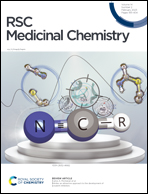A cationic amphiphilic peptide chaperone rescues Aβ42 aggregation and cytotoxicity†
Abstract
Directing Aβ42 to adopt a conformation that is free from aggregation and cell toxicity is an attractive and viable strategy to design therapeutics for Alzheimer's disease. Over the years, extensive efforts have been made to disrupt the aggregation of Aβ42 using various types of inhibitors but with limited success. Herein, we report the inhibition of aggregation of Aβ42 and disintegration of matured fibrils of Aβ42 into smaller assemblies by a 15-mer cationic amphiphilic peptide. The biophysical analysis comprising thioflavin T (ThT) mediated amyloid aggregation kinetic analysis, dynamic light scattering, ELISA, AFM, and TEM suggested that the peptide effectively disrupts Aβ42 aggregation. The circular dichroism (CD) and 2D-NMR HSQC analysis reveal that upon interaction, the peptide induces a conformational change in Aβ42 that is free from aggregation. Further, the cell assay experiments revealed that this peptide is non-toxic to cells and also rescues the cells from the toxicity of Aβ42. Peptides with a shorter length displayed either weak or no inhibitory effect on Aβ42 aggregation and cytotoxicity. These results suggest that the 15-residue cationic amphiphilic peptide reported here may serve as a potential therapeutic candidate for Alzheimer's disease.



 Please wait while we load your content...
Please wait while we load your content...